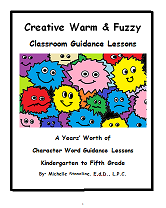The Paradox Between Childhood Giftedness & The Autism Spectrum
By: Briana Cowles
Autism spectrum disorder (ASD) is the name for a category of
developmental disorders. ASD includes a
wide range, or “spectrum,” of skills, symptoms, and levels of disability. Typically, people with ASD have the following
characteristics: ongoing social problems including difficulty communicating and
interacting with peers, repetitive behaviors combined with limited interests, and
symptoms that impair the individual’s ability to function socially, at
school/work, or in any other areas of life.
These symptoms typically manifest in the child’s first two years
(Bradshaw and Sheppard, 2000).
Depending on severity of symptoms, some people are mildly impaired, while others are left severely disabled. Research has shown that treatments and services (such as counseling) have been proven to improve a person’s symptoms and ultimately their ability to function and overall life satisfaction (Melillo and Leisman, 2010). Previously, Asperger’s Syndrome and Autistic Disorder were separate entities and were listed as subcategories within the diagnosis of “Pervasive Developmental Disorders.” However, these subcategories were eliminated following the publication of the latest edition of the manual from the American Psychiatric Association, the Diagnostic and Statistical Manual of Mental Disorders (DSM-5). Alternatively, the manual includes a range of characteristics and severity within one category.
People whose symptoms were previously diagnosed as either Asperger’s Syndrome (AS) or Autistic Disorder (AD) are now included as part of the category referred to as Autism Spectrum Disorder. Seemingly in contrast, gifted children tend to be those who demonstrate asynchronous development. They possess atypical high cognitive abilities and high intensities that enable them to not only experience, but relate to the world in a very unique way. They typically achieve extremely high test scores or may be prodigies in areas such as science, math, language, and/or the arts.
Highly gifted children demonstrate characteristics such as the extreme need to: learn at a much faster pace, process material to a greater depth, show incredible intensity in energy, imagination, sensitivity, intellectual prowess, and emotion which are nonconforming of the general population (Wallace & Acklaw, 1982). Giftedness and Autistic Spectrum Disorder are not mutually exclusive; it is not uncommon for them to co-exist.
Currently, there is no data that documents the prevalence of gifted and talented children with ASD, however, there are several clinical cases and classroom anecdotes of this co-existence. Additionally, it should be noted that in many individuals, symptoms of ASD may obscure giftedness; whereas in others, giftedness can mask characteristics of ASD. To fully comprehend the paradox of an ASD diagnosis and a gifted child, the analysis of the impact the recent DSM-5 modifications have on negative stigma (particularly related to Asperger’s Syndrome), co-morbidity of ASD and other neurobehavioral disorders of childhood, motor dyscoordination as a significant symptom, the basic structure of the human brain, and the genetic aspect of ASD are required.
The recent DSM-5 modifications of ASD have resulted in confusion and lasting stigma for those previously diagnosed with either AS or AD. Currently, AS falls on the autistic spectrum, which has become increasingly controversial as it is argued that a negative stigma is attached to autism that was not previously correlated with AS (Ohan, Ellefson, & Corrigan, 2015).
Additionally, with the publication of the DSM-5, new criteria for a diagnosis of ASD have emerged. People with ASD must now show persistent deficits including: constant social communication and social interaction, and restricted and repetitive patterns of behavior. People with ASD must demonstrate (past or present) deficits in social-emotional reciprocity, deficits in nonverbal communicative behaviors used for social interaction, as well as deficits in developing maintaining and understanding relationships.
These children must show at least two types of repetitive patterns of behavior such as stereotyped or repetitive motor movements; insistence on monotony or an inflexibility to routine; highly restricted, fixated interests or hyper activity to sensory input or unusual interest in sensory aspects of the environment (Ohan, Ellefson, & Corrigan, 2015). Finally, under DSM-5, clinicians are required to rate severity of these deficits.
This leads to a subjective diagnosis with arguably vague symptoms as there is no consistent anatomic or physical markers which results in difficulty distinguishing conditions (Melillo & Leisman, 2010). These amended guidelines for a diagnosis of ASD have led to confusion regarding the current status of previously diagnosed children and may be accountable for a rapidly growing negative stigma surrounding children with an ASD diagnosis; adding to the social difficulty these children have both in and out of a classroom setting.
Co-morbidity is defined as the simultaneous presence of two or more chronic diseases in the same patient. ASD is found to have high rates of co-morbidity with several other neurobehavioral disorders, including but not limited to: Attention Deficit Hyperactivity Disorder (ADHD), Obsessive Compulsive Disorder (OCD), Tourette’s syndrome (TS), learning disability, dyslexia, and pervasive development (Ohan, Ellefson, & Corrigan, 2015). While it is unlikely that a child have three or more different psychiatric conditions simultaneously, it has been theorized that the co-morbidity of these conditions exist because these disorders have similar underlying genotypes (Boren-Cohen et.al, 2002). The diagnosis of a comorbid disorder is especially crucial regarding ADHD.
Similarities between ADHD and ASD are significant when looking at symptoms associated with ADHD as autistic individuals may be hyperactive, but also present with executive dysfunction in attention, impulsivity, and distractibility (Scientific American Mind, 2014). Often, this hyperactive element of an ASD diagnosis clouds a child’s gifted abilities, resulting in a growing disconnect between the child’s capabilities and eagerness to further their education.
Conceivably the most prominent symptom of ASD that masks marked giftedness in a child is motor dyscoordination. Motor dyscoordination is a significant sign in ASD and is speculated that the type of motor incoordination may be able to differentiate between high functioning autistic (HFA) individuals from what was formerly AS as individuals diagnosed with ASD will have significant degrees of motor incoordination (Melillo & Leisman, 2010). Gross motor skills are most frequently affected, fine motor, specifically graphomotor, skills were considered significant in AS.
Agility and gross motor skills in children with ASD seem to decrease as they become older and may eventually present similar or at the same level as AS, and the criteria of HFA may thus fluctuate by age from first diagnosis (Boren-Cohen et.al, 2002). Other symptoms previously associated with AS consisted of severe impairment and social interaction difficulties, preoccupation with a topic, pedantic (dull, dense) language, comprehension and dysfunction of nonverbal communication. A significant difference between AS and non-AS individuals is hand-eye coordination- a symptom that plays an increasingly imperative role as to where a child falls on the spectrum following a diagnosis with ASD (Scientific American Mind, 2014).
Understanding basic structure of the human brain is critical to fully comprehend a diagnosis of ASD. Both classic autism and AS are right hemisphere disorders. Neural substrates, which are particularly important in executive function, working memory, and ADHD, are constituted of nigrostriatal structures. These structures contribute essential, superordinate control of functions such as shifting mental set, sequencing, and planning action. It is currently speculated that developmental disorders may result from a general change in some aspect of brain development such as neuronal number, connectivity, metabolism, structure, or neurochemistry.
General change may have differential impact across different domains of cognition, with more complex aspects of cognition, such as executive function. This may involve varying levels of dopamine depletion in the prefrontal cortex as dopamine has a directly positive effect on the gain in the activation function of the neural networks underlying attentional processing (Bradshaw and Sheppard, 2000). A comprehension of the basic structure of the brain involves an understanding of neuron theory- the concept that the nervous system is composed of discrete individual cells, plasticity- lasting change to the brain throughout the course of life, and evolutionary growth of the human brain (Melillo and Leisman, 2010).
Evolution and cognition can be viewed as having developed from movement. Two main characteristics that make human beings unique among all organisms. The first being that we are that we are bipedal; we have a significantly larger brain in relation to body size, especially the cortex. The second, standing and walking upright is the most sophisticated and complex movement any organism has achieved to date.
The human brain has developed to a greater complexity and size due to the intricacy involved with a dependence on the increased environmental stimuli that accompanies walking upright (Bradshaw and Sheppard, 2000). Understanding how the brain has evolved in terms of movement clarifies ASD when viewing the diagnosis in terms of symptoms, particularly those of motor dyscoordination. Moreover, understanding the awry pathways in an ASD mind will better prepare and assist educators to create specific learning guidelines to help these children perform at their optimum levels.
Finally, there are known genetic aspects of ASD. Autism is considered the most heritable of neurodevelopmental disorders, largely due to the immense difference in concordance rates between monozygotic (identical) and dizygotic (fraternal) twins. The largest genetic study of ASD identified as many as 65 genes that contribute to autism, 28 of which there is a very high confidence they play a role in the risk of a child developing ASD.
Understanding when, where, and how these genes interact, researchers will be able to better focus on the developmental time period, precise brain region, and cell type disrupted in autism (Dorris et.al, 2004). Additional research as confirmed that there are six larger regions of genome that are prone to de novo copy number variants (dnCNVs) that contribute to the risk of developing ASD. Copy-number variations (CNVs) are a form of structural variation that manifest within the genome as deletions or duplications and most are stable and heritable; dnCNVs, however, arise through diverse mechanisms at various stages of development, implying that although ASD is highly heritable, it is not necessary for a there to be a presented family history to receive a diagnosis (Melillo and Leisman, 2010).
Evaluating gifted children and ASD is an immensely complex process that requires a comprehensive understanding of not only the condition, but of gifted criteria. It is critical to evaluate the child’s particular impairments as well as their talents- it is not uncommon for a child to be socially awkward and hyperactive, yet have extraordinary intellectual functioning. Obtaining a full understanding of the DSM-5 modifications, co-morbidity, motor dyscoordination, brain structure, and genetics involved in an ASD diagnosis will assist in counterbalancing the paradoxical impact of accommodating difficulties and developing strengths.
Resources:
Are people with Asperger's “different” from everybody else? (2014). Scientific American Mind
Sci AmMind, 25(3), 74-74.
Baron-Cohen, S., Wheelwright, S., Griffin, R., Lawson, J., & Hill, J. J. (2002). The Exact Mind:
Empathizing and Systemizing in Autism Spectrum Conditions. Handbook of Cognitive Development, 491-508.
Bradshaw, J. L., & Sheppard, D. M. (2000). The Neurodevelopmental Frontostriatal Disorders:
Evolutionary Adaptiveness and Anomalous Lateralization. Brain and Language, 73(2),
297-320.
Dorris, L., Espie, C., Knott, F., & Salt, J. (2004). Mind-reading difficulties in the siblings of
people with Asperger's syndrome: Evidence for a genetic influence in the abnormal development of a specific cognitive domain. J Child Psychol & Psychiat Journal of Child Psychology and Psychiatry,45(2), 412-418.
Melillo, R., & Leisman, G. (2010). Neurobehavioral Disorders of Childhood An Evolutionary
Perspective. Boston, MA: Springer US.
Ohan, J. L., Ellefson, S. E., & Corrigan, P. W. (2015). Brief Report: The Impact of Changing
from DSM-IV ‘Asperger’s’ to DSM-5 ‘Autistic Spectrum Disorder’ Diagnostic Labels on
Stigma and Treatment Attitudes. J Autism Dev Disord Journal of Autism and Developmental Disorders, 45(10), 3384-3389.
Wallace, B., & Acklaw, J. (1982). Giftedness: Definition and Identification. Gifted Education
International, 1(1), 3-5. doi:10.1177/026142948200100102
Disclaimer: This website and its content is intended for trained licensed mental health professionals and school certified mental health professionals to use for their clients / students at their own discretion.
*If you ignore the disclaimer above are using these techniques on yourself and you feel any discomfort or upset it is highly suggested that you seek out a licensed mental health professional immediately.
"Beyond Art Therapy" is the concept from Dr. Stangline that combines all creative fields in therapy. It is not the traditional "art therapy" but goes beyond to include sand tray therapy, play therapy, mindfulness, meditation, color therapy, cognitive behavioral therapy, and a vast majority of other therapies.
For any other type of mental health emergency call your local 911 / Police Number immediately.
Dr. Stangline does not offer advice / suggestions to anyone who is not a professional mental health provider, or a student who is studying this field and has questions about mental health programs of study.
See our Exciting Selection of eBooks:
Award Winning:
Creative Counseling 101 eBook
Our Best Seller!
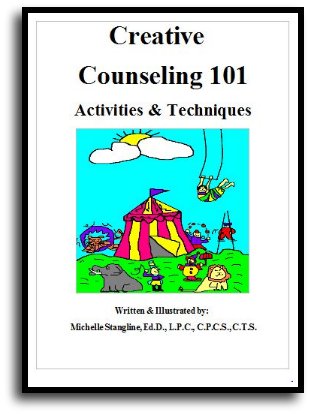
Step By Step Therapy:
Learn how to be a more Creative Therapist with the Book that started it all!
- Graduate School Counseling book used by hundreds of graduate counseling students!
- Includes full color reproducible worksheets with most activities.
- Winner of the Counselor Writer of the Year Award, 2011, Georgia Regional Award
Download Your Copy Today Only $39.95:
See Creative Counseling 101 eBook Information Here:
Get the Set
of all four
eBooks for only $98.95:
An incredible collection of how to do therapy eBooks!
A $159.80 Value,
You Save Over $60!
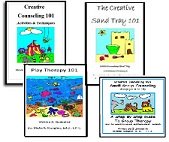
Get your complete set of the Creative Counseling 101.com eBooks by Dr. Michelle Stangline for only $98.95, that's less than $25.00 per eBook (Regular Price is $39.95 for each eBook.).
Your complete set includes:
- Creative Counseling 101
- Creative Group Counseling 101
- Creative Play Therapy 101
- Creative Sand Tray 101
For more information click the link below:
See Complete Set of eBooks For Sale Here:
New!!! "Beyond Art Therapy" 101 eBook
Over 300 pages of Beyond Art Therapy activities and techniques. Learn what I teach graduate counseling students!
See the link below for more information.
Only $39.95
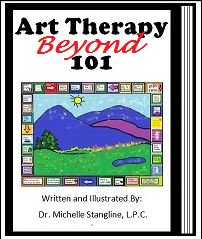
See More Invividual eBooks For Sale:
Sand Tray Therapy 101 eBook:
Learn how to do Sand Tray Therapy or enhance your skills.
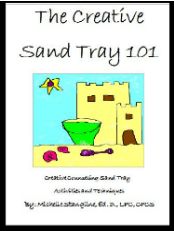
Play Therapy 101 eBook
Learn how to do play therapy or enhance your skills.
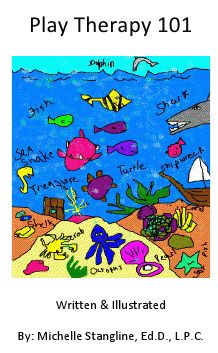
Small Group Counseling eBook For Sale:
Learn how to do creative group therapy and enhance your skills.
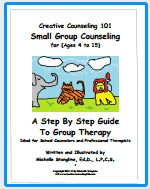
School Counselor Guidance Lesson & Social Stories eBook for sale:
Get a year's worth of school counselor guidance lessons with "Creative Warm & Fuzzy Classroom Guidance Lessons eBook". Introduce your students to the "Warm & Fuzzy Way". Click the link below for more information:
Warm & Fuzzy School Counselor Guidance Lessons eBook
